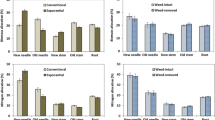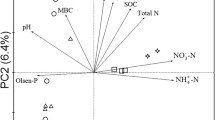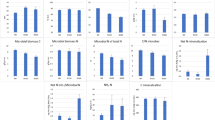Abstract
The effects on growth and nutrient status of an increased availability of all major nutrients was studied in a 40 year old Douglas fir stand. The nutrient amounts were applied by daily sprinkling and were in fixed, optimal proportions to the estimated annual uptake of N. Irrigation was included to avoid drought stress. The nutrient applications were also done in combination with a lower NH4 load, realized under a roof that was placed above the ground. According to nutritional standards nitrogen supply was optimal and was related to the moderately high atmospheric N inputs. Nutrition of P, K and in some years Ca seemed critical.
In all four studied growing seasons water additions resulted in a growth increase, of 30 to 40%. Irrigation decreased needle fall. Nutrient applications increased the needle concentrations of P and K considerably, but this did not result in a growth enhancement. Fertilization also increased K and P in shedded needles. Only minor leaching losses were calculated. The recovery in trees of fertilizer K and P was maximally 15%. Input-output budgets suggested that P was strongly retained in the soil. The decrease in NH4 load had slightly decreased N availability and soil acidification, and seemed to enhance tree growth. The use of tree growth as a parameter to evaluate the effects of an improved nutritional balance is discussed.
Similar content being viewed by others
References
Anonymous 1990 Final Report-Commission on Forest Fertilization Recommendations. Ministry of Agriculture, (former) Department of Forestry and Landscaping, NL. Rep. no. 1990–11, 63 p (In Dutch).
Beier C and Rasmussen R 1993 EXMAN-Experimental manipulation of forest ecosystems in Europe. Commission of the European Communities Environmental Research Report 7, Brussels, Belgium. 124 p.
Binkley D and Reid P 1984 Long-term response of stem growth and leaf area to thinning and fertilization in a Douglas-fir plantation. Can. J. For. Res. 14, 656–660.
Cumming J R, Eckert R T and Evans L S 1986 Effect of aluminium on 32P uptake and translocation by red spruce seedlings. Can. J. For. Res. 16, 864–867.
Dagan G and Bresler E 1983 Unsaturated flow in spatially variable fields. 1. Derivation of models of infiltration and redistribution. Water Resour. Res. 19, 413–420.
DeKam M, Versteegen C M, Van denBurg J and Van derWerf D C 1991 Effects of fertilisation with ammonium sulphate and potassium sulphate on the development of Sphaeropsis sapinea in Corsican pine. Neth. J. Plant Pathol. 5, 265–274.
De Visser P H B, Beier C, Rasmussen L, Kreutzer K, Steinberg N, Bredemeier M, Blanck K, Farrell E P and Cummins T 1994 Biological response of five forest ecosystems to input changes of water, nutrients and atmospheric loads. For. Ecol. Manage. (In press).
Evers F H and Hüttl R F 1990 A new fertilization strategy in declining forests. Water Air Soil Pollut. 54, 495–508.
Flaig H and Mohr H 1992 Assimilation of nitrate and ammonium by the Scots pine (Pinus sylvestris) seedling under conditions of high nitrogen supply. Physiol. Plant. 84, 568–576.
Flückiger W and Braun S 1992 Nitrogen deposition and its consequences for nutrient imbalances and hostplant-parasite relationships. Proceedings 15th International meeting of Specialists in Air Pollution Effects on Forest Ecosystems, IUFRO-Centennial, Tharandt/Dresden, Germany, 9–11 September 1992. 194p.
Foy C D, Chaney R L and White M C 1978 The physiology of metal toxicity in plants. Annu. Rev. Plant Physiol. 29, 511–566.
Hüttl R F 1990 Nutrient supply and fertilizer experiments in view of N saturation. Plant and Soil 128, 45–58.
Ingestad T 1979 Mineral nutrient requirements of Pinus sylvestris and Picea abies seedlings. Physiol. Plant. 45, 373–380.
Ingestad T 1988 A fertilization model based on the concept of nutrient flux density and nutient productivity. Scan. J. For. Res. 3, 157–173.
Keltjens W G and VanLoenen E 1989 Effects of aluminium and mineral nutrition on growth and chemical composition of hydroponically grown seedlings of five different forest tree species. Plant and Soil 119, 39–50.
Keyes M R and Grier C C 1981 Above-and belowground net production in 40-year-old Douglas-fir stands on low and high productivity sites. Can. J. For. Res. 11, 599–605.
Landmann G 1988 Les recherches sur le deperissement des forest en France: structure et principaux resultats du programme DEFORPA. In Air Pollution and Ecosystems. Ed. PMathy. pp 261–284. Reidel, Dordrecht, The Netherlands.
Larsen J B 1983 Trockenresistenz, Wasserhaushalt und Wachstum junger Douglasien (Pseudotsuga menziesii (Mirb.) Franco) und Küstentanne (Abies grandis (Dougl.) Lindley) in Abhängigkeit von der Nährstoffversorgung. Forstl. Forsøgsvaes. Dan. 39, 1–82.
Linder S and Axelsson B 1982 Changes in carbon uptake and allocation patterns as a result of irrigation and fertilization in a young Pinus sylvestris stand. In Carbon Uptake and Allocation in Subalpine Ecosystems as a Key to Management. Ed. R HWaring. pp 38–44. Forest Research Laboratory, Oregon State University, Corvallis, USA.
Marschner H 1991 Mechanisms of adaptation of plants to acid soils. Plant and Soil 134, 1–20.
Mohren G M J, Van denBurg J and Burger F W 1986 Phosphorus deficiency induced by nitrogen input in Douglas fir in the Netherlands. Plant and Soil 95, 191–200.
Mohren G M J, Jorritsma I T M, Vermetten A W M, Kropff M J, Smeets W L M and Tiktak A 1992 Quantifying the direct effects of SO2 and O3 on forest growth. For. Ecol. Manage. 51, 137–150.
Nihlgård B 1985 The ammonium hypothesis—an additional explanation to the forest decline in Europe. Ambio 14, 2–8.
Olsthoorn A F M and Tiktak A 1991 Fine root density and root biomass of two Douglas-fir stands on sandy soils in the Netherlands. II. Periodicity of fine root growth and estimation of belowground carbon allocation. Neth. J. Agric. Sci. 39, 61–77.
Pérez-Soba M and Van derEerden L M J 1993 Nitrogen uptake in needles of Scots pine (Pinus sylvestris L.) when exposed to gaseous ammonia and ammonium fertilizer in the soil. Plant and Soil 153, 231–242.
Runge M 1983 Physiology and ecology of nitrogen nutrition. In Encyclopedia of Plant Physiology 12C. Eds. O LLange, P SNobel, C BOsmond and HZiegler. pp 163–200. Springer-Verlag, Berlin.
Schulze E-D and Freer-Smith P H 1990 An evaluation of forest decline based on field observations focussed on Norway spruce, Picea abies. In Acidic Deposition: its Nature and Impacts. F T Last and R Watling. pp 155–168. The Royal Society of Edinburgh Proc. 97.
Schulze E-D, DeVries W, Hauhs M, Rosén K, Rasmussen L, Tamm C O and Nilsson I 1990 Critical loads for nitrogen deposition on forest ecosystems. Water Air Soil Pollut. 48, 451–456.
Shepard J P and Mitchell M J 1990 Nutrient cycling in a red pine plantation thirty-nine years after potassium fertilization. Soil Sci. Soc. Am. J. 54, 1433–1440.
Smiley R W 1974 Rhizosphere pH as influenced by plants, soil and nitrogen fertilizers. Soil Sci. Soc. Am. Proc. 38, 795–799.
Smits T F C 1992 The vitality of the Dutch forest 10. Report of the national survey. Ministry of Agriculture, Nature Management and Fisheries, The Hague, The Netherlands. pp 1–17 (In Dutch).
Soil Survey Staff 1975 Soil Taxonomy: A basic system of classification for making and interpreting soil surveys. USDA-SCS Agric. Handb. 436, US Government Printing Office, Washington DC, US.
Tiktak A and Bouten W 1992 Modelling soil water dynamics in a forested ecosystem III: model description and evaluation of discretization. Hydrol. Processes 6, 455–465.
VanBreemen N, Burrough P A, Velthorst E J, VanDobben H, DeWit T, Ridder T B and Reijnder H F R 1982 Soil acidification from atmospheric ammonium sulphate in forest canopy throughfall. Nature 299, 548–550.
VanBreemen N and VanDijk H F G 1988 Ecosystem effects of atmospheric deposition of nitrogen in the Netherlands. Environ. Pollut 54, 249–274.
Van denBurg J 1991 Research and experiences from fertilization experiments in the Netherlands. Fert. Res. 27, 107–111.
Velthorst E J 1993 Manual for chemical water analyses. Dept. Soil Science and Geology, Agric. Univ. Wageningen.
Waring R H 1985 Imbalanced forest ecosystems: Assessments and consequences. For. Ecol. Manage. 12, 93–112.
Walinga I, Van Vark W, Houba V J G and Van der Lee J J 1989 Plant analysis procedures. Department of Soil Science and Plant Nutrition, Wageningen Agricultural University, 263 p.
Whitehead D C and Lockyer D R 1987 The influence of the concentration of gaseous ammonia on its uptake by the leaves of Italian ryegrass, with and without an adeqaute supply of nitrogen to the roots. J. Exp. Bot. 38, 818–827.
Author information
Authors and Affiliations
Rights and permissions
About this article
Cite this article
De Visser, P.H.B. Effects of irrigation and balanced fertilization on nutrient cycling in a Douglas fir stand. Plant Soil 168, 353–363 (1995). https://doi.org/10.1007/BF00029348
Issue Date:
DOI: https://doi.org/10.1007/BF00029348




